
Top 30 Java Collection Framework Interview Questions and Answers
Sep 24, 2025 6 Min Read 4211 Views
(Last Updated)
Are you preparing for a Java interview and wondering what kind of questions might pop up, especially around the infamous Collection Framework?
No matter if you’re applying for a junior developer role or aiming for a senior position, Java Collection Framework interview questions are almost inevitable. This framework is the foundation for data manipulation in Java, from storing objects efficiently to retrieving them in the most optimal way.
In this article, we’ve compiled a comprehensive list of the top 30 Java Collection Framework interview questions, categorized by difficulty levels — beginner, intermediate, advanced, and real-world scenarios — so you can walk into your next interview with clarity and confidence.
Table of contents
- Fresher-Level Java Collection Framework Interview Questions
- What is the Java Collection Framework?
- What is the difference between a Collection and a Collections class?
- What is the difference between List, Set, and Map?
- What is the difference between ArrayList and LinkedList?
- Explain the working of HashSet.
- How does HashMap work internally?
- Can a Map contain duplicate keys?
- What are the main interfaces in the Collection Framework?
- What is the default capacity of an ArrayList?
- How do you convert an array to a List?
- Test Your Knowledge: MCQs
- Intermediate-Level Java Collection Framework Interview Questions
- What is the difference between Iterator and ListIterator?
- How do you remove duplicates from a List in Java?
- What are fail-fast and fail-safe iterators?
- What is the difference between HashMap and TreeMap?
- How do you sort a list of objects in Java?
- What is the significance of equals() and hashCode()?
- How can you make a collection thread-safe?
- What is the difference between ArrayDeque and LinkedList as a Queue?
- How do you copy elements from one collection to another?
- Write a Java code to count occurrences of each word in a list.
- Advanced-Level Java Collection Framework Interview Questions
- What is the load factor in HashMap, and how does it affect performance?
- How does ConcurrentHashMap prevent thread interference?
- What is IdentityHashMap, and where is it used?
- What is WeakHashMap, and its use cases?
- How does TreeMap ensure sorting? Can we sort in descending order?
- Scenario-Based Java Collection Framework Interview Questions
- Scenario: You're asked to store employee records in such a way that employee IDs are unique and easily searchable. What would you use?
- Scenario: Your application logs events and needs to maintain the order of events. Which collection do you choose?
- Scenario: You need to process a large number of read operations and a few writes concurrently. Which collection is best?
- Scenario: You have to sort a list of student objects based on their grade. How will you approach this?
- Scenario: You’re building a scheduler where the next task should always be the one with the highest priority. Which data structure do you use?
- Test Your Knowledge: MCQs
- Conclusion
Fresher-Level Java Collection Framework Interview Questions

If you’re just starting your journey in Java development, understanding the core components of the Java Collection Framework is essential. These questions will help you solidify your basics and demonstrate a strong foundational grip during interviews.
1. What is the Java Collection Framework?
The Java Collection Framework (JCF) is a set of classes and interfaces that implement commonly reusable data structures such as lists, sets, queues, and maps. It provides algorithms to perform operations like sorting and searching.
2. What is the difference between a Collection and a Collections class?
- A collection is an interface that represents a group of objects.
- Collections is a utility class in java.util that provides static methods to operate on collections (like sort(), reverse()).
3. What is the difference between List, Set, and Map?
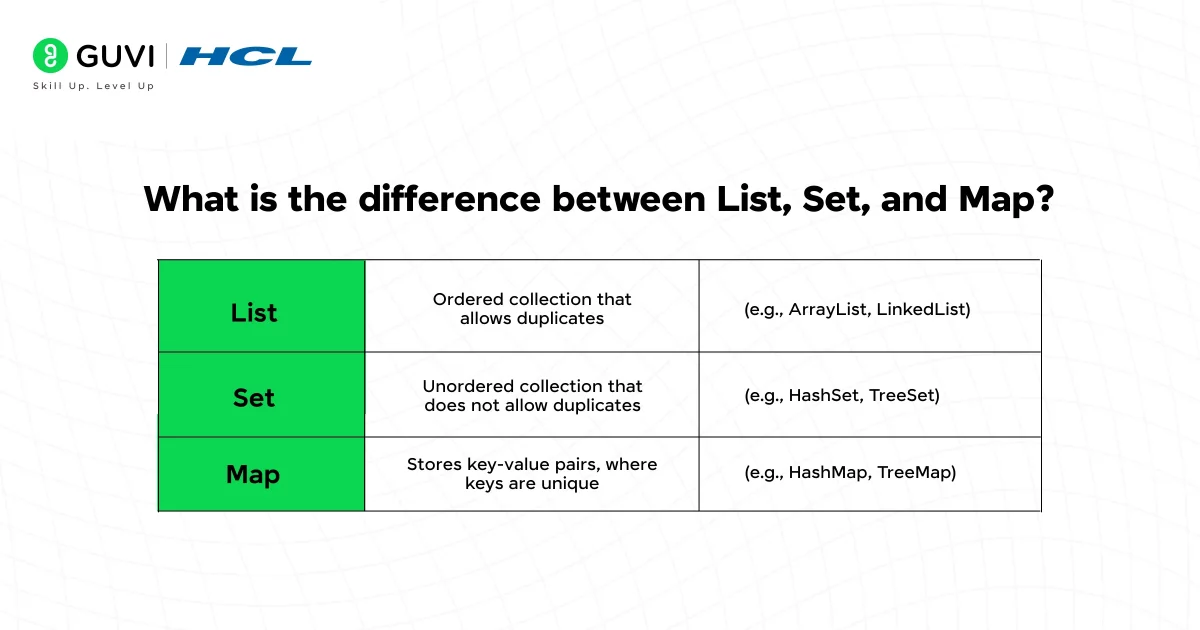
- List: An ordered collection that allows duplicates (e.g., ArrayList, LinkedList)
- Set: Unordered collection that does not allow duplicates (e.g., HashSet, TreeSet)
- Map: Stores key-value pairs, where keys are unique (e.g., HashMap, TreeMap)
4. What is the difference between ArrayList and LinkedList?
- ArrayList: Fast for random access, slow for insertions/deletions in the middle.
- LinkedList: Slower access time but better performance for add/delete in the middle.
5. Explain the working of HashSet.
HashSet uses a HashMap internally to store elements. It ensures uniqueness by using hashCode() and equals() methods to prevent duplicates.
6. How does HashMap work internally?
HashMap stores data in buckets using an array of Node<K,V>. The key’s hashCode determines the bucket index. If collisions occur, elements are stored in a linked list or balanced tree, depending on the load.
7. Can a Map contain duplicate keys?
No, a Map cannot have duplicate keys. Each key must be unique, but values can be duplicated.
8. What are the main interfaces in the Collection Framework?
Some core interfaces include:
- Collection
- List
- Set
- SortedSet
- Queue
- Map
- SortedMap
9. What is the default capacity of an ArrayList?
The default capacity of an ArrayList is 10.
10. How do you convert an array to a List?
You can use:
List<String> list = Arrays.asList(array);
Test Your Knowledge: MCQs
Q1. Which of the following allows duplicate elements in Java?
- a) HashSet
- b) TreeSet
- c) ArrayList
- d) HashMap
✅ Answer
c) ArrayList — ArrayList allows duplicate elements, unlike Set implementations.
Q2. Which interface is the root of the Collection hierarchy?
- a) List
- b) Map
- c) Collection
- d) Iterable
✅ Answer
c) Collection — The Collection interface is the root of the collection hierarchy.
Intermediate-Level Java Collection Framework Interview Questions
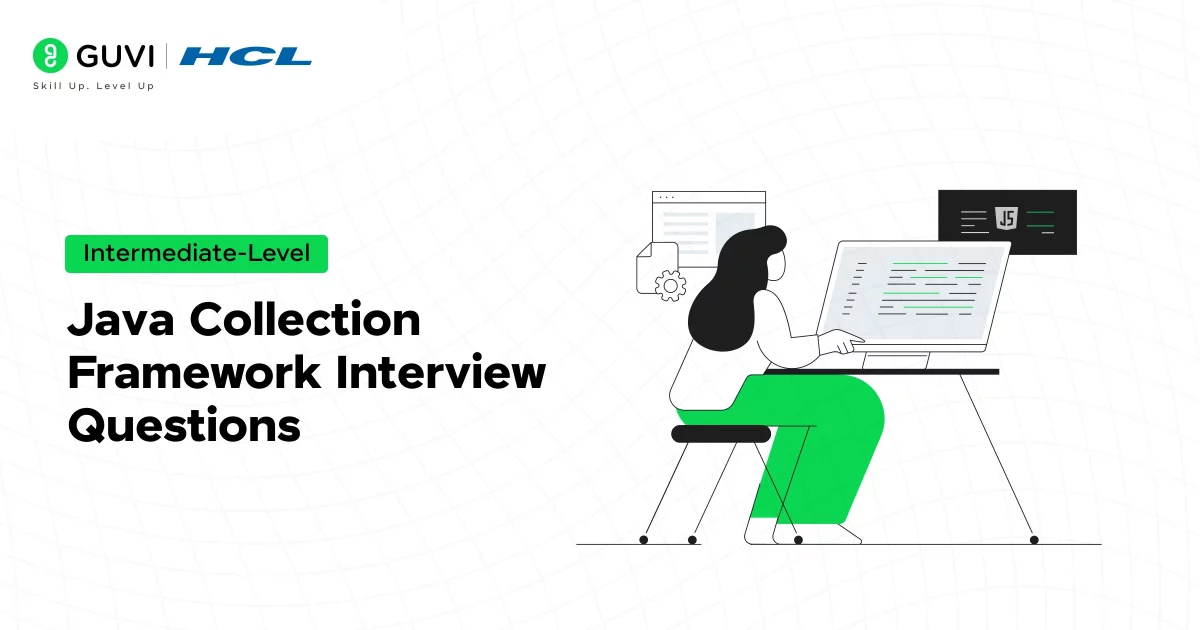
Once you’re comfortable with the fundamentals, it’s time to dive deeper. These intermediate questions explore more nuanced topics like performance, iteration, and real-world usage of collections, preparing you for hands-on coding and problem-solving scenarios.
11. What is the difference between Iterator and ListIterator?
Both Iterator and ListIterator are used to iterate through collections, but they differ in capabilities and scope:
- Iterator:
- Available for all Collection types (List, Set, Queue).
- Can traverse only in the forward direction.
- Can remove elements during iteration using remove().
- ListIterator:
- Only available for List implementations like ArrayList and LinkedList.
- Supports bidirectional traversal (forward and backward).
- Provides additional methods like add(), set(), previous(), and hasPrevious().
If you need more flexibility during traversal, such as moving back and forth or modifying the list structure, ListIterator is preferred.
12. How do you remove duplicates from a List in Java?
To remove duplicates from a List, the most straightforward way is to use a Set, since sets don’t allow duplicate elements.
List<Integer> list = Arrays.asList(1, 2, 2, 3, 4, 4);
Set<Integer> set = new LinkedHashSet<>(list); // Maintains insertion order
list = new ArrayList<>(set);Alternatively, for more control (e.g., using streams):
List<Integer> uniqueList = list.stream().distinct().collect(Collectors.toList());
This is efficient and leverages Java 8+ features.
13. What are fail-fast and fail-safe iterators?
- Fail-Fast Iterators:
- Immediately throw ConcurrentModificationException if the collection is modified while iterating.
- These iterators are used in most standard collection classes like ArrayList, HashSet, and HashMap.
- Fail-Safe Iterators:
- Work on a cloned copy of the collection, so structural modifications don’t affect the iterator.
- Used in concurrent collection classes like ConcurrentHashMap and CopyOnWriteArrayList.
Fail-safe iterators are more memory-intensive but are safer in multi-threaded environments.
14. What is the difference between HashMap and TreeMap?
| Feature | HashMap | TreeMap |
| Ordering | No guaranteed order | Maintains keys in natural order |
| Performance | Faster (O(1) access) | Slower (O(log n)) due to tree ops |
| Null keys/values | Allows one null key and values | Does not allow null keys |
| Implementation | Backed by a hash table | Backed by a Red-Black Tree |
Use HashMap when speed is a priority. Use TreeMap when sorted data is required.
15. How do you sort a list of objects in Java?
Sorting custom objects requires using Comparable or Comparator.
Using Comparable (natural ordering):
class Employee implements Comparable<Employee> {
String name;
public int compareTo(Employee other) {
return this.name.compareTo(other.name);
}
}
Collections.sort(employeeList);Using Comparator (custom ordering):
Collections.sort(employeeList, Comparator.comparing(Employee::getSalary));
For descending order:
employeeList.sort(Comparator.comparing(Employee::getSalary).reversed());
16. What is the significance of equals() and hashCode()?
When working with collections like HashSet or HashMap, the correct implementation of equals() and hashCode() ensures object uniqueness and consistent behavior.
- equals(): Determines if two objects are logically “equal”.
- hashCode(): Returns an integer hash used for bucketing.
17. How can you make a collection thread-safe?
Several approaches can be used:
Synchronized Wrapper:List<String> syncList = Collections.synchronizedList(new ArrayList<>());
Concurrent Collections:
- ConcurrentHashMap
- CopyOnWriteArrayList
- BlockingQueue
Manual Synchronization:
synchronized(list) {
list.add("item");
}Using concurrent collections is usually more efficient and scalable in multithreaded applications.
18. What is the difference between ArrayDeque and LinkedList as a Queue?
Both ArrayDeque and LinkedList implement the Deque interface and can be used as queues or stacks.
| Feature | ArrayDeque | LinkedList |
| Performance | Faster due to no node overhead | Slightly slower due to node links |
| Null elements | Does not allow nulls | Allows nulls |
| Use cases | Best for stack/queue operations | Good for both queue/list ops |
Use ArrayDeque when you only need queue behavior, and performance is a priority.
19. How do you copy elements from one collection to another?
You can copy using:
Collections.copy(destinationList, sourceList);
However, the destination list must be of equal or greater size. A safer approach would be:
List<String> copy = new ArrayList<>(originalList);
20. Write a Java code to count occurrences of each word in a list.
Here’s a simple implementation using HashMap:
List<String> words = Arrays.asList("apple", "banana", "apple", "orange", "banana");
Map<String, Integer> wordCount = new HashMap<>();
for (String word : words) {
wordCount.put(word, wordCount.getOrDefault(word, 0) + 1);
}
for (Map.Entry<String, Integer> entry : wordCount.entrySet()) {
System.out.println(entry.getKey() + ": " + entry.getValue());
}This approach is efficient and ideal for word-frequency use cases in interviews or coding rounds.
Advanced-Level Java Collection Framework Interview Questions
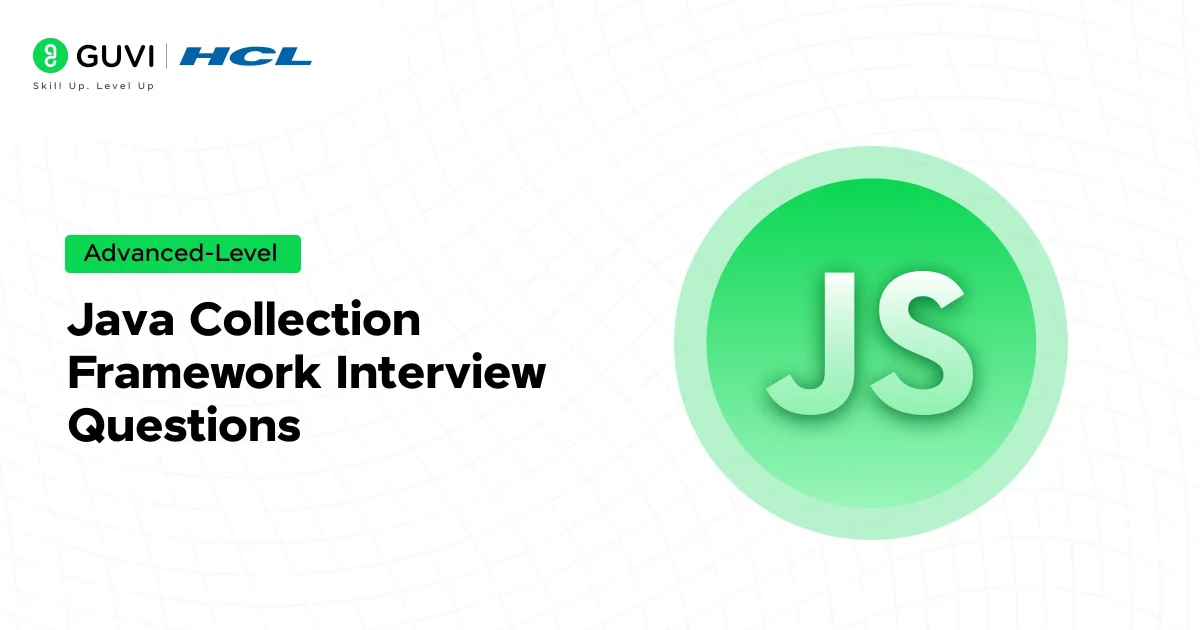
At the advanced level, interviewers often look for your ability to reason about internal mechanics, thread safety, and optimized usage of collections. These questions will test both your theoretical knowledge and your ability to write scalable, efficient code.
21. What is the load factor in HashMap, and how does it affect performance?
The load factor of a HashMap determines how full the map can get before it needs to be resized (rehashed). The default load factor is 0.75, which means when 75% of the capacity is filled, the map resizes and rehashes its contents to a larger internal array (typically double the size).
Why it matters:
- Low load factor (e.g., 0.5): Less collision, better performance, but uses more memory.
- High load factor (e.g., 0.9): Saves memory but increases the likelihood of collisions and slows down access.
Choosing the right load factor is about balancing space and time efficiency.
22. How does ConcurrentHashMap prevent thread interference?
ConcurrentHashMap is a thread-safe implementation of Map. Unlike HashMap, which throws ConcurrentModificationException during concurrent access, ConcurrentHashMap handles it efficiently using bucket-level locking (Java 7) or CAS (Compare-And-Swap) with synchronized blocks (Java 8+).
Key mechanisms:
- Segments (in Java 7): Only a portion (segment) of the map is locked, not the entire map.
- Bin-level locking (in Java 8+): Locks only specific buckets instead of entire segments.
- No locking on read operations: Multiple threads can read simultaneously.
- Write operations are synchronized at the bucket level.
This makes it highly performant and suitable for high-concurrency environments.
23. What is IdentityHashMap, and where is it used?
IdentityHashMap is a special implementation of Map that uses reference equality (==) instead of logical equality (equals()) for comparing keys.
Use case:
When you want to distinguish between objects that are logically equal but have different references in memory.
Map<String, String> map = new IdentityHashMap<>();
map.put(new String("key"), "value1");
map.put(new String("key"), "value2");
System.out.println(map.size()); // Output: 2This is useful in low-level frameworks, caching mechanisms, or scenarios involving object identity.
24. What is WeakHashMap, and its use cases?
WeakHashMap is a type of map where keys are stored as weak references. This means that if a key is no longer in ordinary use (i.e., there are no strong references to it), it becomes eligible for garbage collection.
Use case: Ideal for building caches where entries should be removed automatically when the key is no longer used elsewhere in the application.
25. How does TreeMap ensure sorting? Can we sort in descending order?
TreeMap is a Red-Black Tree-based implementation of the SortedMap interface. It keeps the keys in natural order (e.g., alphabetical for strings, ascending for numbers) or in the order defined by a custom comparator.
Sorting in descending order:
TreeMap<Integer, String> map = new TreeMap<>(Collections.reverseOrder());
map.put(1, "A");
map.put(3, "C");
map.put(2, "B");
// Output: {3=C, 2=B, 1=A}Internally, TreeMap maintains the order dynamically as elements are added or removed.
Scenario-Based Java Collection Framework Interview Questions

These simulate real-world problems to evaluate your decision-making ability using the Java Collection Framework.
26. Scenario: You’re asked to store employee records in such a way that employee IDs are unique and easily searchable. What would you use?
In this case, a HashMap<Integer, Employee> is ideal, where the key is the unique employee ID.
Benefits:
- Fast O(1) lookup for employee records.
- Easy to update or remove entries by ID.
- Ensures ID uniqueness naturally through key constraints.
Map<Integer, Employee> employeeMap = new HashMap<>();
employeeMap.put(101, new Employee("John", "Design"));27. Scenario: Your application logs events and needs to maintain the order of events. Which collection do you choose?
For maintaining insertion order, LinkedHashMap or LinkedList are good choices.
- LinkedHashMap: Useful if you need key-value pairs with predictable iteration order.
- LinkedList: Suitable for a simple list of event strings or objects.
Map<String, Event> eventLog = new LinkedHashMap<>();
eventLog.put("Start", new Event(...));
eventLog.put("Stop", new Event(...));This ensures the logs are processed in the same order they occurred.
28. Scenario: You need to process a large number of read operations and a few writes concurrently. Which collection is best?
ConcurrentHashMap is best suited here.
- It supports high-concurrency read operations.
- Uses internal partitioning to reduce lock contention.
- Handles occasional writes without compromising read performance.
Ideal for caching or real-time data access where read throughput is critical.
29. Scenario: You have to sort a list of student objects based on their grade. How will you approach this?
Implement a Comparator<Student> for the grade field and use Collections.sort() or the List.sort() method.
Collections.sort(studentList, Comparator.comparing(Student::getGrade));
If sorting by multiple fields:
studentList.sort(Comparator.comparing(Student::getGrade)
.thenComparing(Student::getName));This approach is clean, readable, and customizable.
30. Scenario: You’re building a scheduler where the next task should always be the one with the highest priority. Which data structure do you use?
Use a PriorityQueue<Task> with a custom comparator that orders tasks by priority.
PriorityQueue<Task> queue = new PriorityQueue<>(
Comparator.comparingInt(Task::getPriority).reversed()
);Tasks with the highest priority will be polled first, ensuring an efficient scheduling mechanism.
In case you want to learn more about Java and gain in-depth knowledge on full-stack development, consider enrolling for HCL GUVI’s certified Java Full-stack Developer Course that teaches you everything from scratch and makes sure you master it!
Test Your Knowledge: MCQs
Q3. Which collection provides thread-safe iteration without throwing ConcurrentModificationException?
- a) HashMap
- b) CopyOnWriteArrayList
- c) ArrayList
- d) LinkedList
✅ Answer
b) CopyOnWriteArrayList — It provides thread-safe iteration and does not throw ConcurrentModificationException.
Q4. In ConcurrentHashMap, how is concurrency achieved?
- a) By synchronizing the entire map
- b) By segmenting the map and locking only part of it
- c) By using Vector internally
- d) By blocking all read operations
✅ Answer
b) By segmenting the map and locking only part of it — ConcurrentHashMap uses segmented locking for better concurrency.
Conclusion
In conclusion, mastering the Java Collection Framework is not just about understanding data structures; it’s about knowing when and why to use them. These 30 questions are designed to give you a well-rounded perspective on everything from the fundamentals to the intricacies of concurrent and specialized collections.
If you can answer these confidently, you’re not only prepared for interviews but also well-equipped to write cleaner, more efficient Java code in real-world applications. Keep practicing, keep coding, and revisit these questions often to sharpen your edge.

























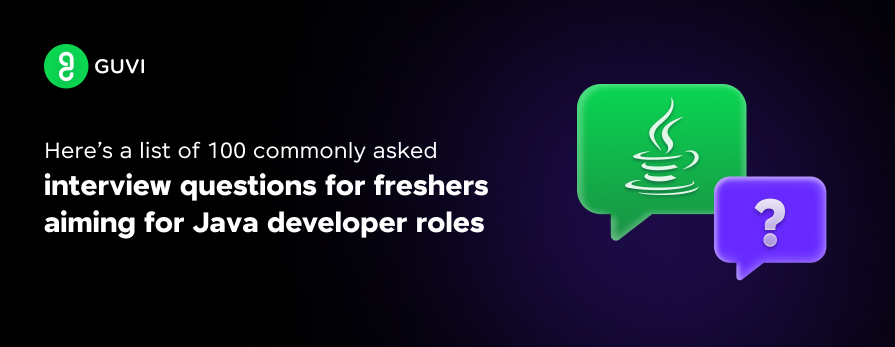

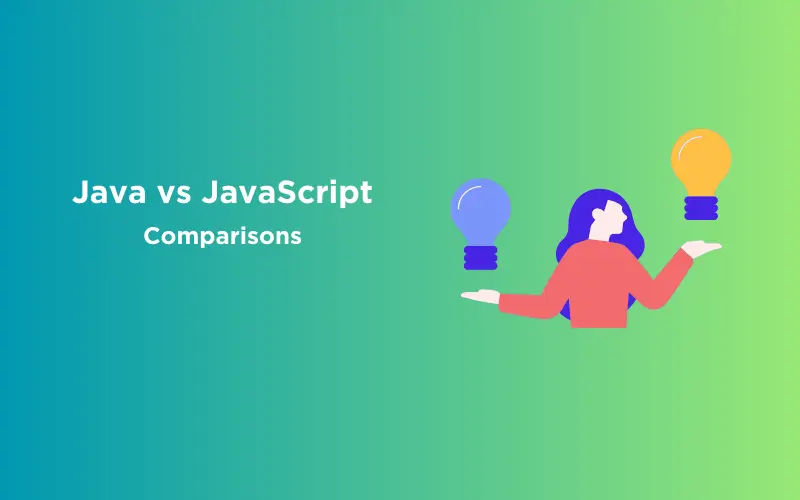






Did you enjoy this article?